Bran Castle, Romania, inaugurated an unique Time Tunnel, a museum that comes to life, but unless you’re obsessed with the history of Romania it will help to know beforehand what is each exhibit’s connection with Bran Castle. So here’s all you need to know before visiting the Time Tunnel at Bran – or a virtual one.
Vertical Gallery of Bran Castle
Horizontal Gallery of Bran Castle
About the entrance in the Time Tunnel at Bran Castle
Know that when the medieval Bran Castle was built (first as a wooden fortress erected by the Teutonic Knights around 1220, then as a stone castle built by the hands of the Saxons living in Brașov, and finished by 1388) it had a seven meters deep water reservoir dug into the castle’s courtyard.
It was during the 17th century when the reservoir became a 59 meters deep well dug into the mountain rock. The travelers who stopped at Bran Castle often mentioned the distinctive taste of the water from the castle’s inner well.
In 1937 Bran Castle received a new well and the old well was repurposed and turned into an elevator shaft. This elevator (holding three people) and a following 40 meters winding, horizontal gallery allowed Queen Marie of Romania access to the Royal Gardens located at the bottom of the rock on which Bran Castle rises.


Today, the vertical and the horizontal galleries form the Time Tunnel of Bran Castle.
What to see in the Vertical Gallery of the Bran Castle’s Time Tunnel (yes, from the glass elevator)
A modern, smart, glass elevator (with emergency exit, earthquake and gas sensors and all) named Stone takes nearly one minute to go down a 31 meters modernized, reinforced shaft. This is the longest approved distance between two elevator stops.

Know that during the first eight meters of this trip descending you can see the original rock tiles still covering the walls of the elevator shaft, the ones used during 1937 when the elevator was designed by architect Karel Liman for Queen’s Marie of Romania. This section of the elevator shaft was even declared a historical monument.
You can catch a glimpse of the process of creation, construction and installation of the Stone Elevator inside Bran Castle’s Time Tunnel on Youtube here. Stone Elevator is the 100% bespoke brainchild Elmas Factory from Brașov, Romania.
Know that, while in the elevator, you will also catch glimpses of:
- Elegant Ghosts strolling around the castle’s dark corridors,
- A Dragon breathing fire,
- Ielele, supernatural maidens dancing and singing under the moonlight,
- And, if you are lucky, even a Cloud of Bats coming at ya’!
Great company for the nearly 60 seconds you get to spend in the glass elevator, isn’t it?
But why this selection from the Romanian folklore? I am a writer, a reader, and a dreamer, so here’s my take on it.

Ghosts. We were lucky to visit Bran Castle many times, and I always enjoyed its calm and cozy atmosphere, the wood embracing its walls and creaking underfoot. Yet it appears that there is quite an amount of paranormal activity happening here, as its Museographer mentions in an interview for a Romanian magazine.
“If you look too much into the past, the future might fail to find you.”
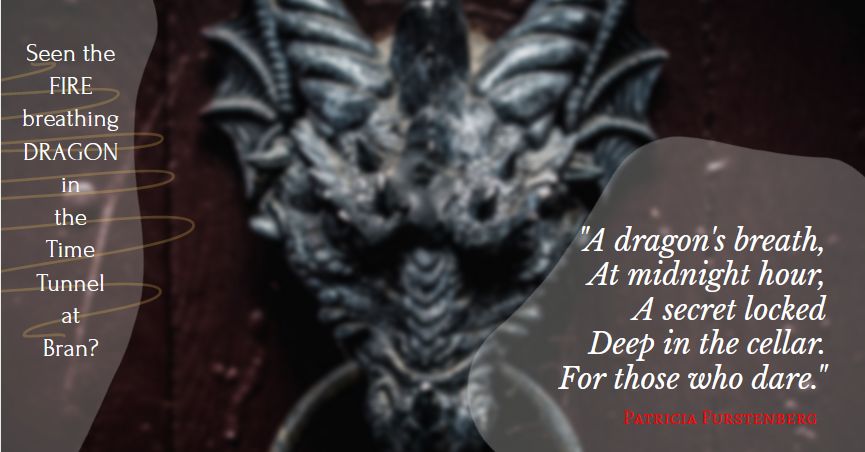
Dragons breathing fire (balaur in Romanian) populate Romanian folklore and folktales. Sometimes a dragon would prey upon a maiden, and a brave lad must come to her rescue. Other times a dragon would dwell inside a well… Word goes, if you pay attention to the stories that go around the fire, that when two dragons fight, the weather gets as angry as a bear. And then there are those dragons too, called zmei in Romanian, that are kept hidden in caves underground by their weather-bending masters, the wizards Solomonari.
“A dragon’s breath,
At midnight hour,
A secret locked
Deep in the cellar.
For those who dare.”
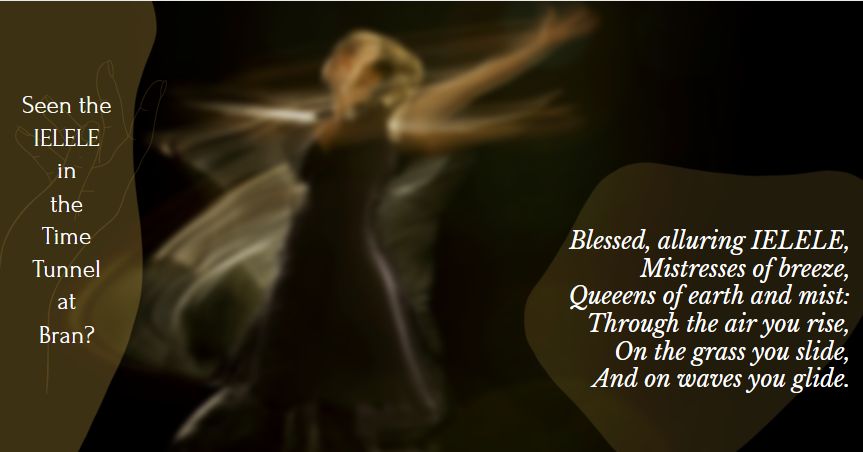
Ielele are most feared feminine creatures from Romanian mythology, “Mistresses of breeze, Ladies of the earth and mist.” They are described as fairies (zâne in Romanian), with great seductive powers over men and with magic skills – not to be confused with Sânzienele, the protectors of nature. Ielele would join hands and dance in a circle, hora, in lonely places such as dark forests or deserted plains. And under their feet the grass turns to ash. Ielele are similar to nymphs, naiads, dryads of Greek mythology, and Samodivas of Bulgarian folklore.
“Blessed, alluring IELELE,
Mistresses of breeze,
Queens of earth and mist:
Through the air you rise,
On the grass you slide,
And on waves you glide.”
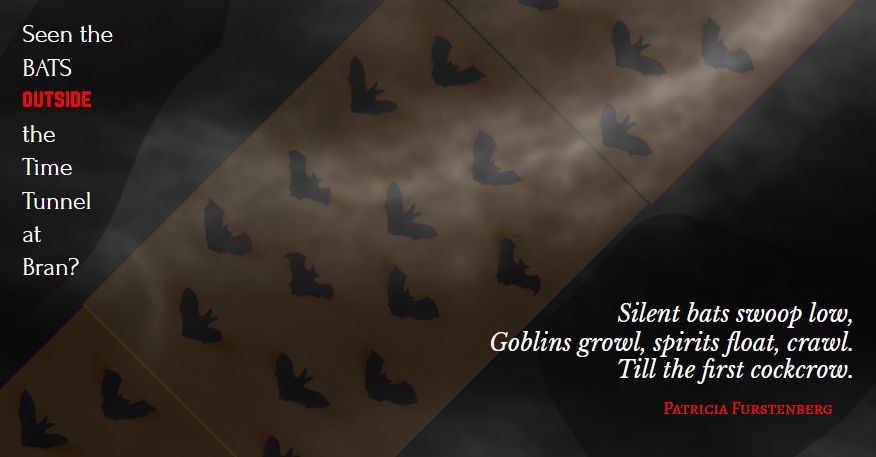
Bats are probably the easiest to associate with Bran Castle, since Bram Stoker used a similar fortress as the setting for his Count Dracula’s lair in his renowned gothic novel (more on this in my next blog post).
From Paleolithic times men drew bison, deer, or horses on cave walls and then stroke them with their weapons in a warrior ritual, convinced that it will help them capture the real animals. Primitive man saw these sketched animals as ‘second bodies’ of the real ones, the ones made from flesh and blood.
From here humankind moved to ancient funeral rites filled with animal symbols, then one more large step was all it took and we have the duality, the image of body & soul, with the soul envisaged as a cloud, a butterfly, a mouse, a dog, a rooster, a bat… or a wolf – and I’m thinking here of the Dacians’ belief that they were daoi, wolfs (in spirit).
A bat. Why a bat at Bran?
With its spiraling, erratic flight like a constant struggle, its nocturnal lifestyle, never quite succeeding in leaving that dark place where it appears to be trapped… Nor bird, nor animal, associated with murkiness and witchcraft and shrouded in a dark cloak, the bat came to symbolize the souls of those often departed from this world as a result of a violent death, and returned – between midnight and the cock’s crow – to demand justice. Or so the folk belief goes.
From bats at Bran Castle to vampires?
The shortest link would be bats -> vampire bats -> vampires -> Bram Stoker’s Darcula -> Vlad Dracula -> Vlad the Impaler -> Bran Castle.
But what if there is a better connection between bats and vampires?
Know that Romanians don’t traditionally believe in vampires, we have strigoii, souls that can rise from the grave. The belief in vampires is encountered in Serbo-Croatian culture.
Then something happened during the 18th century in eastern-Europe and the fear of vampirism sky-rocketed. And linguists became interested in this prickly word, vampire.
18th century antiquary and clergy Samuel Pegge ingeniously derived the word vampire
from the French avant- père, ancestor. My Oxford English Dictionary mentions French, Hungarian (vampir), and Turkish (uber, witch) origins for vampire.
Let’s return to the Serbo-Croatian culture where vampire is vampir/вампир (Bosnian), vampir (Croatian), upír (Czech and Slovak) with its proposed proto-Slavic root ǫpyrь, ǫpirь, reading opyr. Opyr comes from a word meaning bat and the etymological sense of opir/opyr is “to fly, glide, float in the air like vapor.”
So now, from a linguistic point of view, it makes sense to connect bats with vampires, isn’t it?
While researching for his upcoming novel Bram Stoker indeed read a book written by William Wilkinson, former English diplomat who had been stationed in Bucharest, a book that introduced Stoker to Voivode Dracula, Vlad the Impaler. And the rest was Stoker’s imagination. (More on this in my next blog post).
And with this, the Time Tunnel Stone elevator should have safely reached ground floor – level with the park found at the bottom of the rock on which Bran Castle rises.
What to see in the Horizontal Gallery of the Bran Castle’s Time Tunnel
Know that the first six meters are the original stone of the fortress’ ancient tunnel.
Next, a multimedia tunnel presents key images that create a timeline of Bran Castle. Here’s what you will see:
1211, the Teutonic Knights arrive in Burzenland, Țara Bârsei, Transylvania

The Teutonic Knights arrived to Țara Bârsei, Burzenland, invited by King Andrew II of Hungary to defend the Southeastern border of Transylvania (then the eastern-most land conquered by the Hungarian Empire) against the Cumans and the Pechenegs. The King even gifted the Teutonic Knights the land where they soon build a wooden fortress, soon to be known as Bran Castle. The Teutonic Knights received the right to establish markets and administer justice, and were free from taxes and tolls although the king retained his right to mint currency and claim all gold and silver deposits that would be uncovered (knowing well that these mountains were rich in minerals).
1407, Mircea the Elder, Prince of Wallachia, receives Bran Castle as a fief
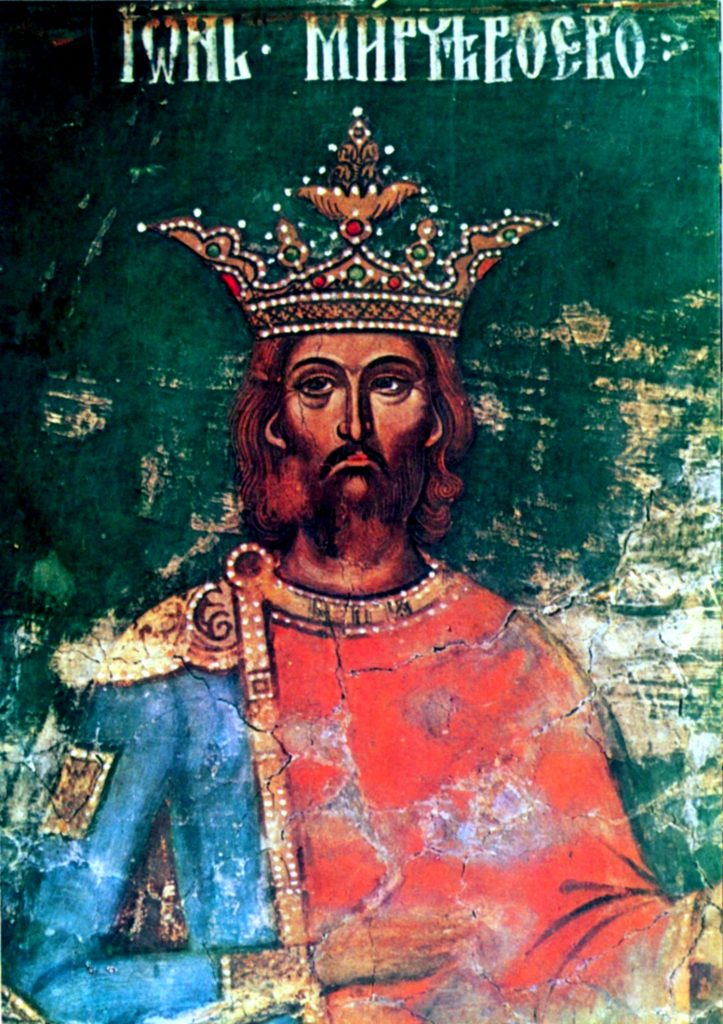
King Sigismund of Luxembourg offers Bran Castle to his ally, Prince Mircea the Elder of Wallachia, as fief, “in return for loyalty”. This way Sigismund recognized the prominent role that the ruler of Wallachia held in the general effort of blocking the Ottoman’s advance in the Balkans.
Mircea the Elder granted the merchants of Brasov (located further up from Bran) commercial privileges, “through the boroughs from Wallachia and on the road from Brasov through the Bran pass up to Braila.”
Mircea the Elder was Vlad the Impaler’s paternal grandfather.
Bran, located in south-eastern Transylvania, was a significant possession for it controlled the Hungarian – Wallachian trade route. There were only three routes connecting Transylvania to Wallachia during medieval times, and Bran Pass was one of them.
The aftermath of a battle, flames engulfing the trees – Bran Castle has seen quite a few wars

1. Battles against the Ottoman Empire held near Bran Castle
For nearly two centuries the Hungarian and Ottoman Empires were at war, and Transylvania and Wallachia were caught in the middle.
Turks first plundered Transylvania in 1400. More attacks followed, and in 1421 the town of Brașov was partially destroyed by the Turks under Sultan Murad II, although its people could take refuge in Brassovia fortress, atop Mountain Tâmpa overlooking Brașov.
The Turks attacked again in 1441 but were defeated near Bran by John Hunyadi, Transylvania’s Voivode around that time. This was not the only battle that Hunyadi fought against the Ottomans on Transylvanian land.
In 1541 Transylvania became an autonomous principality under Turkish suzerainty.
2. Why Vlad the Impaler passed with his troops past Bran in 1460 and attacked Brașov?
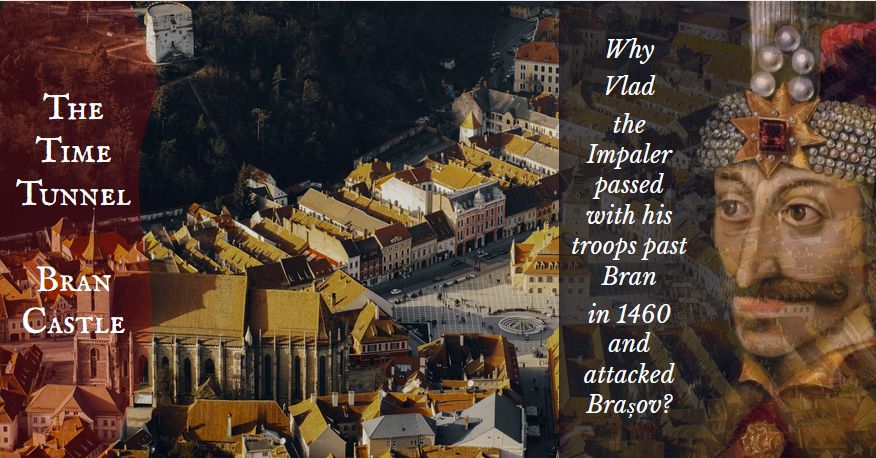
Vlad the Impaler (Vlad Tepes, Vlad III) protected Bran Pass and the city of Brașov against Turkish attacks during his first reign.
In 1458 Matthias Corvinus became King of Hungary and focused solely on ransoming the Holy Crown of Hungary from Emperor Frederick III, Holy Roman Emperor (who had the crown, wishing to gain control over Hungary). At the same time in Transylvania, the Saxons of Brasov and Sibiu (among other towns) supported Emperor Frederick III who was German, and not the Hungarian Corvinus.
Around this time Pope Pius II planned a three year anti-Ottoman crusade without receiving much support from any of the Christian crowned heads of Europe – except for Vlad the Impaler.
Back in In Wallachia (who was bound by peace treaties to pay tribute to the Turks, and was also a Hungarian vassal) Vlad the Impaler was in the process of straightening his country’s economy and putting together an army of mercenaries to face any Turkish attacks. Vlad knew he could not count on Corvinus’ help, and he had just refused to pay the yearly tribute to the Ottomans. With the Hungarian currency weakening, Vlad decided to narrow the commercial privileges the Saxon merchants of Transylvania held in Wallachia.
Because of this, the Saxons of Brașov backed Dan III (from the opposing clan of Dănești – Vlad the Impaler belonged to the Drăculești clan) who also wished to rule Wallachia.
To sum it up… Vlad the Impaler was willing to join the Christian crusade against the Ottomans at a time when his biggest ally, Corvinus, had backed out. Vlad was building up Wallachia’s economy and independence, and was about to face an Ottoman attack by himself; a pretender to the throne of his country suddenly showed up, backed by German villagers from Brasov, a city Wallachia had commercial ties with and that Vlad had protected against the Turks many times before.
So in the summer of 1460 Vlad the Impaler led his troops through Bran Pass and attacked Brașov, getting rid of Dan III, the boyars supporting him and punishing all those who stood against him and Wallachia.
Then a peace treaty was signed with the cities of Brașov and Hermannstadt (Sibiu) and the Burzenland, backed by Matthias Corvinus. Among others, these cities promised to help Vlad the Impaler with 4 000 soldiers in case of a Turkish attack, and Vlad promised to withstand any Turkish attack that would come their way.
3. Over the centuries, Bran Castle saw more battles
A revolt of the Serfs from the villages nearby in 1514; a Turkish attack headed by Mehmed Beg in 1530; an attempt attack against Brasov in 1600 by Nicolae Patrascu, Voivode of Wallachia; the explosion on the powder mill; another riot in July 1785; the Revolution of 1848 and another local riot; the Russo-Turkish war of 1877.
John Hunyadi and the Legend of the Crow
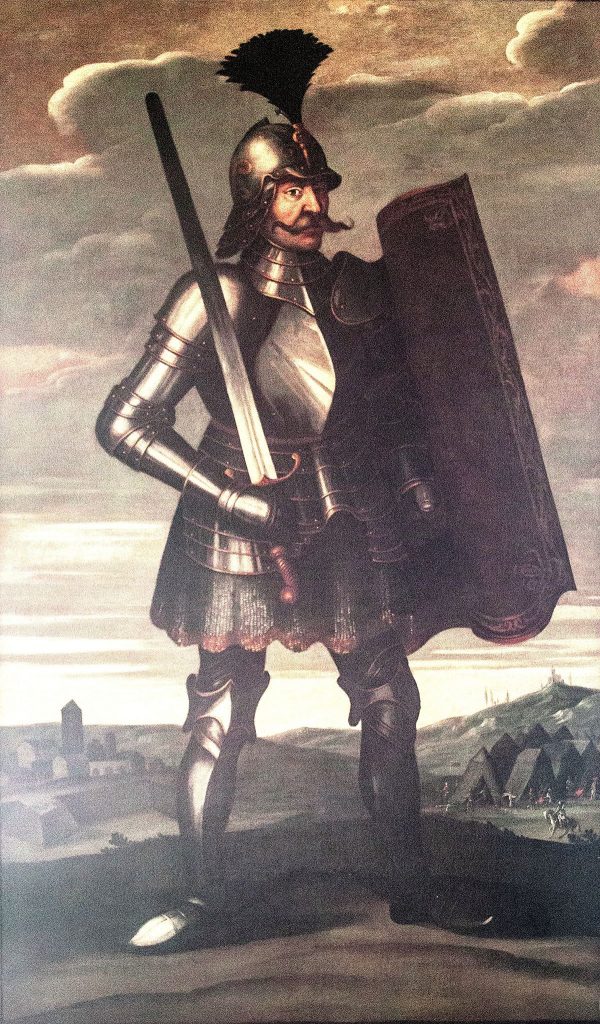
Legend goes that a princely ring was given to the mother of new-born John Hunyadi by none other than Sigismund of Luxembourg, Holy Roman Emperor and, among others, King of Hungary. The gift was meant to help the boy prove his royal descent at a later stage. A raven stole the ring, tells the legend, yet young John killed the bird with an arrow and recovered the precious artifact.
This legend explains the origins of Hunyadi / Corvinus House coat of arms, a mysterious raven (corvus in Latin) with a ring in its beak.
Yet this legend actually dampens John Hunyadi’s incredible rise to military power.
Wait. There is another explanation for Hunyadi’s coat of arms. Don’t you just love history? 🙂
John Hunyadi’s paternal grandfather was a Wallachian named Serb. Serb had Voicu, John’s father, and two other sons, all of them serving the King Sigismund of Luxembourg. Yet Serb still owned land in Wallachia, probably gifted by the Wallachian Voivode for excellent service: the village of Corbi (Ravens) at the foot of Fagaraș Mountains.
1596 – Mihai Viteazul, Michael the Brave, Prince over Wallachia
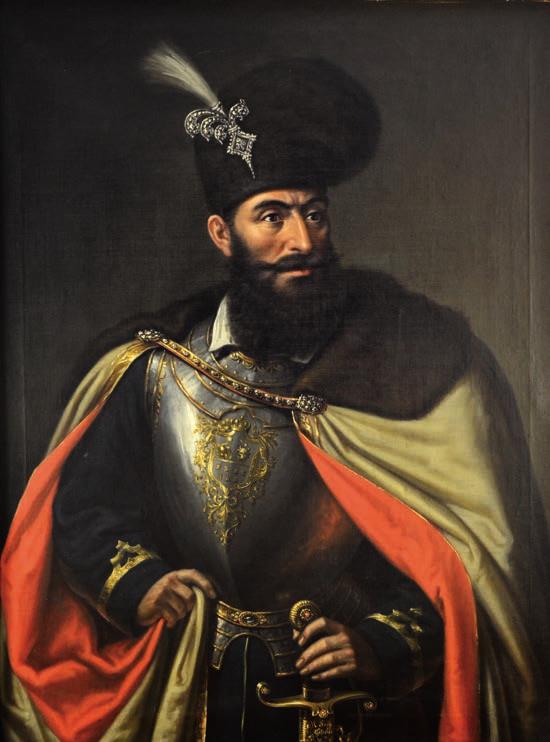
He was Prince of Wallachia (as Michael II, 1593–1601), Prince of Moldavia (1600) and de facto ruler of Transylvania (1599–1600). His reign marked the first time all principalities inhabited by Romanians were under the same ruler.
Michael the Brave and his wife, Lady Stanca, stayed at Bran Castle in December 1596 according to the writings of Dominicus Rosenauer, administrator of Bran at that time. The Wallachian Prince went further to the city of Alba Iulia while his wife remained at Bran awaiting his return.
1920 – Queen Marie of Romania
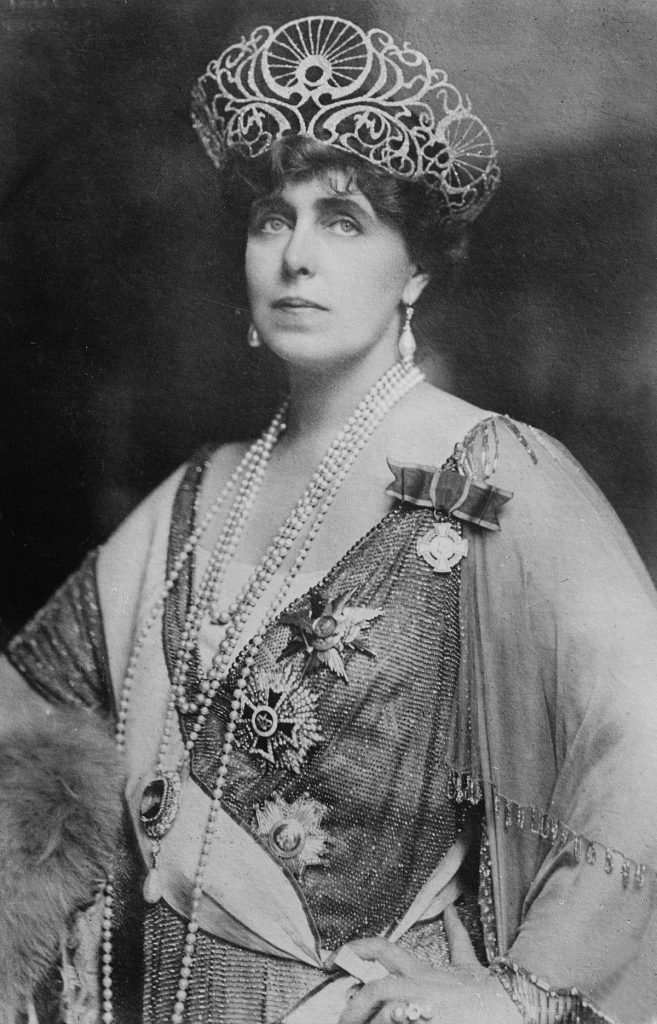
On December 1st 1920 the citizens of Brasov gifted the castle to Queen Maria of Romania, “the great queen who (…) spreads her blessing everywhere she walks, thus wining, with an irresistible momentum, the hearts of the entire country’s population”. The Queen also used Peles Castle as a summer residence.
The Queen reconditioned and refurbished the castle, but still maintaining its original structure.
“Bran,’ the queen remembered, ‘meant a new field of work, the call to life of a new dream about beauty. With the help of a trustworthy, aged architect, but as spirited as me, I began to bring to life the dead walls, to give a soul to this old fortress that had never really lived. I awoke her from a long slumber, I turned a blind house into a home with many eyes open towards the world. Asleep, forgotten, lonely as she was, she proved herself to be no less than what was expected of her, allowing us to turn her into a peaceful and pleasant home.”
Queen Marie of Romania on Bran Castle
1938 – Princess Ileana of Romania

After the death of Queen Marie Bran Castle entered in possession of Princess Ileana, married to Archduke Anton of Austria, who looked after the castle further – until 1948 when the communism regime took over and the Royal Family was exiled from Romania.
In 1961, Ileana entered the Orthodox Monastery of Our Lady of All Protection in Bussy-en-Othe, France. On her tonsuring as a monastic in 1967 Sister Ileana was given the name Mother Alexandra.
The great variety of villagers who lived on Bran estates
One of the last multimedia images in the Time Tunnel at Bran Castle depicts the great variety of villagers that lived and still live in the Bran area: Romanians, Saxons, Hungarians, Jews, Gypsies.
And lastly in the multimedia tunnel:
Bram Stoker’s Dracula in a somehow modern version
WHY is a picture of Bram Stoker’s Dracula in Bran Castle’s Time Tunnel and IF Bram Stoker really based his Gothic anti-hero on the Wallacian Voivode Vlad Dracula (Vlad the Impaler, Vlad III) will make the subject of my next blog post.
You can take a virtual tour of the Bran Castle’s Time Tunnel in this YouTube video (until my video will become available).

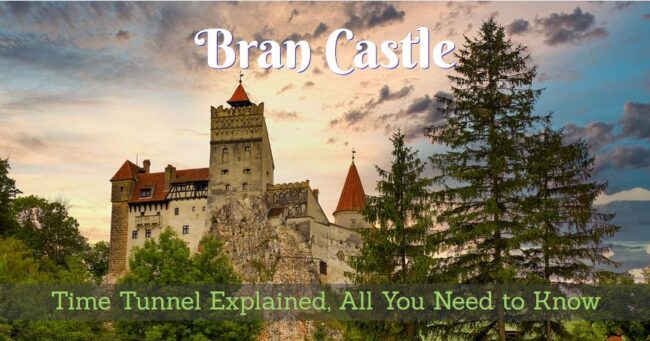
Daca ai sti cat iti apreciez articolele..aceste mici bucatele de istorie, ceva basme etc
Vai, Gia, mersi frumos!! 🙂
fascinating photographs and text….it is extraordinary history and myth
Thank you so much, Michael. Appreciate it.
It bugs me to visit a place and not know what I’m looking at 😉
Feeling sorry for my kids though, next time we’ll visit Bran Castle. Ha ha 🙂
Are you trying to get people visit Bran Castle and the Time Tunnel? Or are you trying to keep people away? Cause there is no way I’d step in that elevator to encounter ghosts, iele, bats and whatnot to get to the garden. 🙂 Just kidding. Your story is so interesting and beautifully written with so many historical details that I already feel like I visited the Time Tunnel. 🙂
I knew it 🙂 I knew you are going to comment on this 😉 That’s why I included “catch glimpses of”. See?
I do appreciate your comments, Jo.
So glad to hear that you enjoyed it!
Oh, I enjoyed it a lot. In fact I spread the word about it. I thought Dracul Van Helsing shouldn’t miss such an informative post. 🙂 But I’ll still need someone to hold my hand if I use that elevator. 🙂
Thank you, Jo 🙂
I think the elevator ride will be done before you know it. And there’s no “pause” button 😉
How about an “I’ve changed my mind, I want to go back” button? 😀
Suppose you’ve already bought your ticket by then? 😉
This is really fascinating! Thanks for all the information.
Beautiful. Thanks for the follow.. lovely to meet you.
Thank you, Cindy 🙂
Such a pleasure meeting you too.
You’re so welcome and the feeling is mutual… YAAAYYYY❣️
Great pleasure, Susan. I enjoyed gathering it all together 🙂
This is looking scary but it is beautiful and seems like hogwarts
Oh, I like this comparison very much! 🙂
Here’s hoping it looks more scary than it is 🙂
Hi Patricia. Thank you for visiting and following HoB. Much appreciated!
Great pleasure, Herman 🙂
Absolutely fascinating!
Thank you so much 🙂
wonderful history and pictures Pat. Thanks for the follow.. I’m now following you as well
Thank you so much, Cindy 🙂
You’re sooooo welclome❣️
Awesome post
Thank you! 🙂
Very beautiful I am one of your biggest followers
Thank you so much 🙂
Welcome here!
Thank you so much
You’re welcome 🙂
Sounds like quite the fascinating place to visit. I wouldn’t mind the ghosts but would definitely avoid the bats.
Ah, thank you, Annemarie 🙂 It is marvelous!
I don’t like the bats either, but (just between the two of us) – they’re not real 😉
I don’t even like fake bats.
Ha ha 🙂 I fully understand 😉
Well, these appear in a short video clip projected on the elevator’s glass cabin.
I particularly enjoyed your exposition about Hunyadi, a long-time hero in my country. Be well.
With great pleasure. One must respect history and all those, known and unknown, who helped us be who we are today.
I do remember John Hunyadi well from my history books 🙂
Thank you for visiting.
I want to thank you again for sharing the sights and history of Romania with all of us. It truly is fascinating! I enjoy reading about it very much. Isn’t using Bram Stoker and the book “Dracula” more of a tourist lure in Romania, and in particular, Transylvania? That’s what friends have told me who have been there. And in documentaries, I’ve seen that Vlad Tepes is a great national hero, and associating him with vampires is actually rather insulting to his memory. Is that correct? The Turks were cruel and ruthless adversaries, and I believe he did what he had to do in order to defeat them.
This is a brilliant question, Dawn. Thank you!
Maybe I can answer to it with a new blog post 😉
My pleasure. I look forward to reading it!